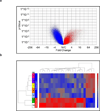Comparative multidimensional molecular analyses of pediatric diffuse intrinsic pontine glioma reveals distinct molecular subtypes
- PMID: 24297113
- PMCID: PMC4028366
- DOI: 10.1007/s00401-013-1218-2
Comparative multidimensional molecular analyses of pediatric diffuse intrinsic pontine glioma reveals distinct molecular subtypes
Erratum in
-
Correction to: Comparative multidimensional molecular analyses of pediatric diffuse intrinsic pontine glioma reveals distinct molecular subtypes.Acta Neuropathol. 2020 Aug;140(2):247. doi: 10.1007/s00401-020-02162-6. Acta Neuropathol. 2020. PMID: 32562017
Abstract
Diffuse intrinsic pontine glioma (DIPG) is a highly morbid form of pediatric brainstem glioma. Here, we present the first comprehensive protein, mRNA, and methylation profiles of fresh-frozen DIPG specimens (n = 14), normal brain tissue (n = 10), and other pediatric brain tumors (n = 17). Protein profiling identified 2,305 unique proteins indicating distinct DIPG protein expression patterns compared to other pediatric brain tumors. Western blot and immunohistochemistry validated upregulation of Clusterin (CLU), Elongation Factor 2 (EF2), and Talin-1 (TLN1) in DIPGs studied. Comparisons to mRNA expression profiles generated from tumor and adjacent normal brain tissue indicated two DIPG subgroups, characterized by upregulation of Myc (N-Myc) or Hedgehog (Hh) signaling. We validated upregulation of PTCH, a membrane receptor in the Hh signaling pathway, in a subgroup of DIPG specimens. DNA methylation analysis indicated global hypomethylation of DIPG compared to adjacent normal tissue specimens, with differential methylation of 24 genes involved in Hh and Myc pathways, correlating with protein and mRNA expression patterns. Sequencing analysis showed c.83A>T mutations in the H3F3A or HIST1H3B gene in 77 % of our DIPG cohort. Supervised analysis revealed a unique methylation pattern in mutated specimens compared to the wild-type DIPG samples. This study presents the first comprehensive multidimensional protein, mRNA, and methylation profiling of pediatric brain tumor specimens, detecting the presence of two subgroups within our DIPG cohort. This multidimensional analysis of DIPG provides increased analytical power to more fully explore molecular signatures of DIPGs, with implications for evaluating potential molecular subtypes and biomarker discovery for assessing response to therapy.
Conflict of interest statement
No potential conflicts of interest were disclosed
Figures







References
-
- Ajit C, Tamhane DDD. Statistics and Data Analysis: From Elementary to Intermediate. Upper Saddle River, NJ: Prentice Hall; 2000.
-
- Angelini P, Hawkins C, Laperriere N, Bouffet E, Bartels U. Post mortem examinations in diffuse intrinsic pontine glioma: challenges and chances. J Neurooncol. 2011;101(1):75–81. - PubMed
-
- Bartels U, Hawkins C, Vezina G, Kun L, Souweidane M, Bouffet E. Proceedings of the diffuse intrinsic pontine glioma (DIPG) Toronto Think Tank: advancing basic and translational research and cooperation in DIPG. J Neurooncol. 2011;105(1):119–125. - PubMed
-
- Baudis M. Progenetix oncogenomic online resource. [Accessed May 3 2013];2012 www.progenetix.net. . http://www.progenetix.org/cgi-bin/projectsHome.cgi?project=DIPG.
Publication types
MeSH terms
Substances
Grants and funding
LinkOut - more resources
Full Text Sources
Other Literature Sources
Medical
Research Materials
Miscellaneous

